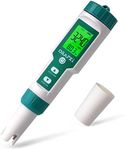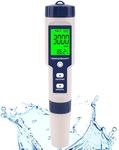Buying Guide for the Best Pool Salt Meters
Choosing the right pool salt meter is essential for maintaining the proper salt levels in your pool, which ensures the water is safe and comfortable for swimming. A pool salt meter helps you measure the concentration of salt in your pool water, which is crucial for the effective operation of saltwater chlorinators. When selecting a pool salt meter, consider the following key specifications to ensure you get the best fit for your needs.AccuracyAccuracy refers to how close the meter's readings are to the actual salt concentration in your pool. This is important because accurate readings ensure that you can maintain the correct salt levels, which is crucial for the effectiveness of your pool's chlorination system. Accuracy is usually expressed as a percentage. For general pool maintenance, a meter with an accuracy of ±0.1% to ±0.5% is sufficient. If you require more precise measurements, look for meters with higher accuracy. Consider your pool's needs and how precise you need the readings to be when choosing the accuracy level.
RangeThe range of a pool salt meter indicates the minimum and maximum salt concentration levels it can measure. This is important because it determines whether the meter can handle the salt levels in your pool. Most residential pools have salt levels between 2,500 to 4,000 parts per million (ppm). Ensure the meter you choose can measure within this range. If you have a commercial pool or a pool with higher salt levels, you may need a meter with a broader range. Choose a meter with a range that comfortably covers your pool's typical salt concentration.
Ease of UseEase of use refers to how simple and straightforward the meter is to operate. This is important because a user-friendly meter will save you time and reduce the likelihood of errors. Look for meters with clear displays, simple calibration processes, and easy-to-understand instructions. Some meters come with automatic temperature compensation, which adjusts readings based on water temperature, making them easier to use. Consider how comfortable you are with using technical devices and choose a meter that matches your comfort level.
DurabilityDurability refers to how well the meter can withstand regular use and exposure to pool water. This is important because a durable meter will last longer and provide reliable readings over time. Look for meters made from high-quality materials that are resistant to corrosion and water damage. Some meters are designed to be waterproof or water-resistant, which can be beneficial if you plan to use them frequently. Consider how often you will use the meter and the conditions it will be exposed to when choosing a durable model.
CalibrationCalibration is the process of setting the meter to a known standard to ensure accurate readings. This is important because regular calibration maintains the meter's accuracy over time. Some meters require manual calibration, while others offer automatic calibration features. Manual calibration involves using a calibration solution and following specific steps, which can be more time-consuming. Automatic calibration is more convenient but may come at a higher cost. Consider how often you are willing to calibrate the meter and choose a model that fits your maintenance preferences.
DisplayThe display of a pool salt meter shows the salt concentration readings. This is important because a clear and easy-to-read display ensures you can quickly and accurately interpret the results. Look for meters with large, backlit displays that are easy to read in various lighting conditions. Some displays also show additional information, such as temperature or battery life. Consider where and when you will be using the meter and choose a display that will be easy to read in those conditions.
















